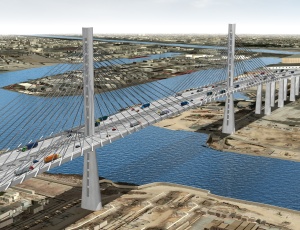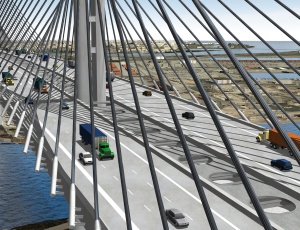The Long Beach Board of Harbor Commissioners last week unanimously approved the Environmental Impact Report for the project to replace the aging Gerald Desmond Bridge at the Port of Long Beach with a new, nearly $1 billion span that will accommodate future traffic needs and dramatically improve safety for vessels and vehicles alike.


The Port of Long Beach, in partnership with Caltrans, will oversee the project to design and build a higher, wider bridge parallel to and just north of the existing Gerald Desmond Bridge. Once the new bridge is completed and open, the old structure will be taken down. The project will generate an average of 4,000 jobs per year during the expected five to six years of construction.
Parsons/HTNB has been on contract for the preliminary design work, which is about 25% complete, according to port spokesman John Pope. �We�re looking at a design/build plan to finish the rest,� he says.
�This is a high priority project both on a national and a local scale,� says Harbor Commission President Nick Sramek. �It benefits both the environment and the economy, and we need to move forward expeditiously.�
�The bridge is obsolete and deteriorating,� says Port Executive Director Richard D. Steinke. �The new bridge will add lanes for improved traffic flow and dedicated safety lanes to keep traffic moving if there�s a breakdown or accident.�
The port says the 42-year-old Gerald Desmond Bridge is a vital route for cargo, carrying about 15% of the nation�s goods. It is also a critical link for commuters, who make up about 75 percent of bridge traffic. The bridge serves as a connection for thousands of vehicles each day between Long Beach and San Pedro, and between Orange County and western Los Angeles County.
The new bridge will have three traffic lanes plus emergency lanes in both directions, making it safer and better able to accommodate cars and trucks on a major Southern California commuting route. The new bridge will be higher to allow for the newest generation of green cargo ships to pass underneath.
The preliminary bridge type selection features a 2,000-ft-long cable-stayed structure with single-mast towers, shear links, composite deck and approach viaducts with 270-ft maximum spans.
The schedule now continues with the RFQ release in September, the draft RFP completed in April followed by Caltrans/FHWA review and approval, proposals due in fall 2001 and selection of winning bid in late 2011.
Along with the environmental certification, the commission also approved additional funds for the Port Mitigation Grant Programs, which are designed to reduce the cumulative air quality impacts from major Port development projects. The commission added $2.4 million to the mitigation grant programs, which now total $17.4 million.

Post a comment to this article
Report Abusive Comment